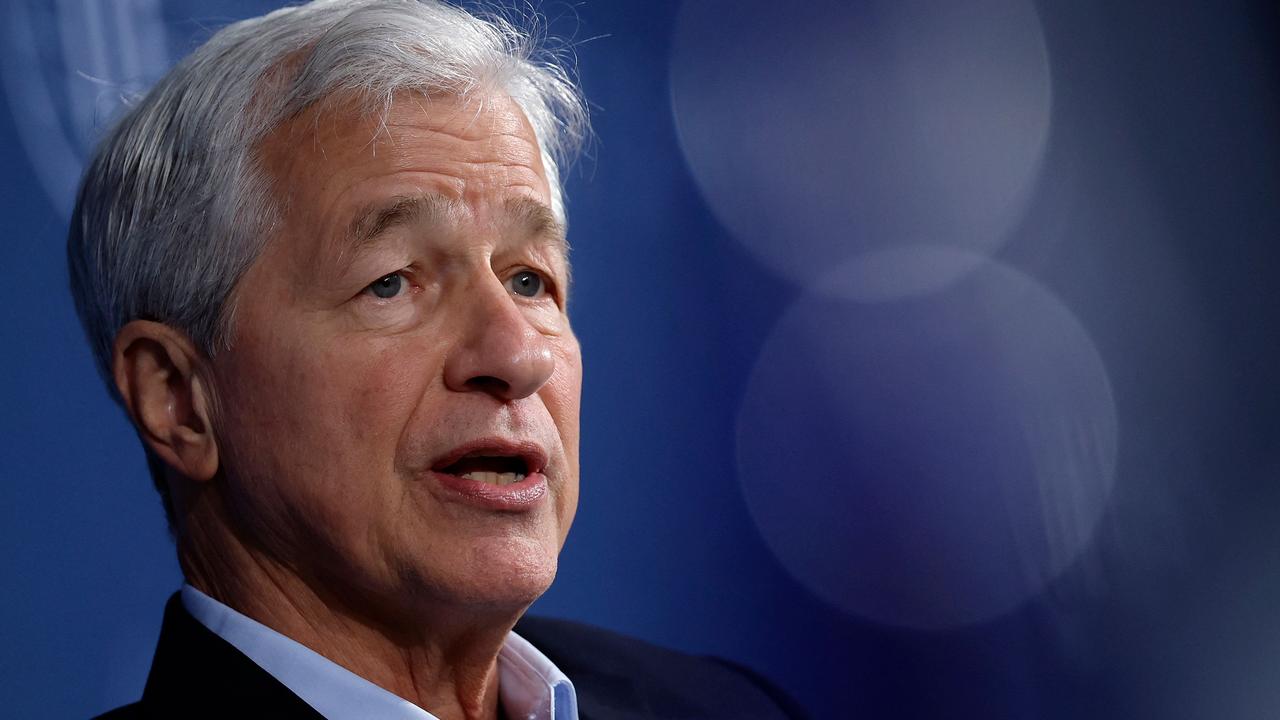North Korea nuclear program: Kim Jong-un’s game plan revealed
NORTH Korea has made a stunning about face in its nuclear program. But these recent satellite images indicate otherwise.
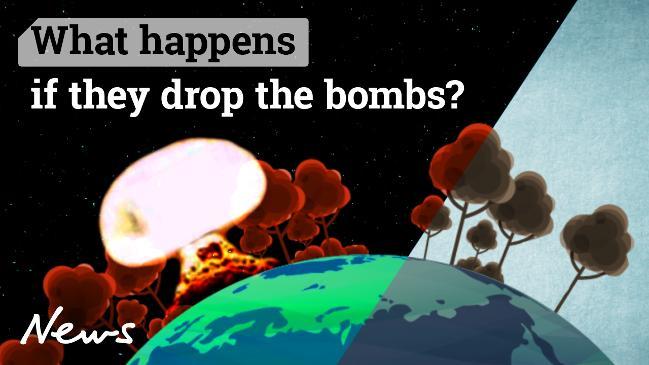
SATELLITE images taken of North Korea’s nuclear complex indicate the regime isn’t winding down its weapons program anytime soon.
While North Korea leader Kim Jong-un appears to have made a stunning about face on his nuclear program, a new analysis has raised fresh questions over the regime’s motives.
The North vowed not to use nuclear weapons against South Korea and said it could impose a ban on further nuclear and missile tests during talks with the United States.
The apparent about face follows the first meeting between Mr Kim and South Korean officials since he took power in 2011.
According to South Korean media, Mr Kim agreed not to use conventional weapons against South Korea and had no reason to possess nuclear weapons if it has a security guarantee.
South Korean security adviser, Chung Eui-yong told local media after the two-day talks in Pyongyang that North Korea committed to denuclearising the Korean peninsula.
However, respected Washington-based monitoring site 38 North has reported that activity is taking place at the North’s Yongbyon Scientific Research Centre, with at least one reactor likely operating.
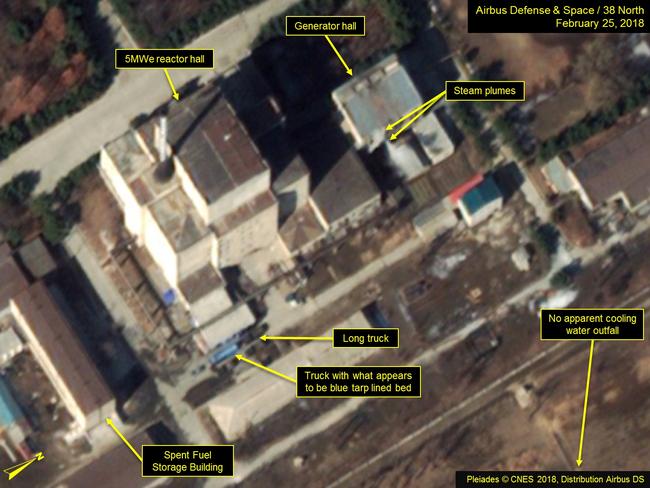
The images, taken on February 25, also show a new military camp.
The analysis of North Korea’s Yongbyon nuclear complex reveals the 5 MWe reactor continues to show signs of operation “as indicated by steam vapour plumes emanating from the generator hall and river ice melt near the reactor”.
While noting that cooling water discharges near the river outfall have not been observed, analysts note the regime may be hiding this by extending the discharge pipe into the river.

Analysts Frank V Pabian, Joseph S Bermudez Jr and Jack Liu suggest if the reactor is operating again then it could only mean North Korea has resumed production of plutonium “presumably for its nuclear weapons program”.
“It also means that the North has likely extended its cooling water pipeline into the river (rather than near the river) to better conceal the reactor’s operational status, making monitoring efforts more difficult going forward,” they write.
READ MORE: What we didn’t notice about Kim’s dinner
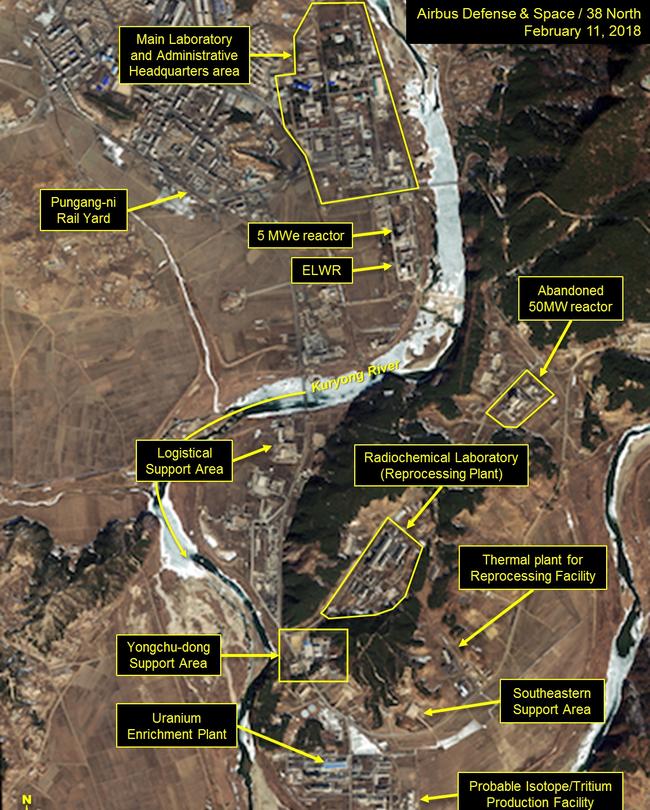
CLEVER PLOY
While the images were taken prior to the North and South’s historic meeting, they will no doubt add to concerns Mr Kim is just buying time for his regime.
John Blaxland, Professor of International Security and Intelligence Studies and director of ANU’s Southeast Asia Institute, told news.com.au Mr Kim was playing a clever game.
“He’s indicating he does not intend to use nuclear weapons against the south, but is indirectly suggesting that he would be prepared to use them elsewhere — such as against Japan,” Professor Blaxland said.
“There being no love lost between Japan and the Koreas, Kim Jong-un’s appeal can be seen as an attempt to drive a wedge between the South Koreans and the United States and its Japanese allies.”
Professor Blaxland also pointed out that Mr Kim was being forced to come up with a new game plan with sanctions clearly beginning to bite.
“An emotionally appealing pitch to the South Koreans, presented without agreeing to the fundamental demands being made by the Trump administration, fits the bill,” he said.
Professor Blaxland said there were clear indications that work is continuing at the Yongbyon nuclear reactor and there’s little reason for the United States to take Kim’s overtures at face value.
“But raised South Korean expectations will generate a demand for some action, some concessions, on the part of the United States,” he said.
“Kim Jong-un, it seems, is working on his own art of the deal.”
Professor Blaxland said it was possible US President Donald Trump may take the North Korean initiative as “a convenient sign that his pressure has been working”.
“He undoubtedly will claim credit for the apparent concession and, if he is sensible, he will capitalise on this to find a way out of further escalatory rhetoric that could be the precursor to war,” he said.
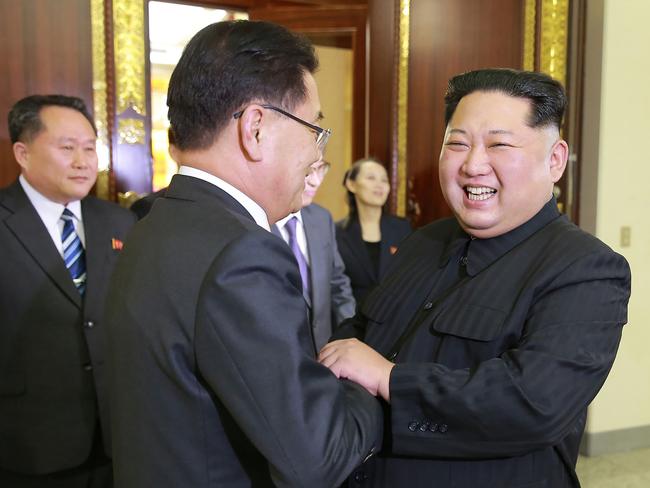
CALCULATING KIM
The top US intelligence official has also raised questions over Mr Kim’s intentions, admitting he remains doubtful about an apparent new overture from North Korea to enter into talks on its nuclear capability.
“I’m quite sceptical about all of this,” Director of National Intelligence Dan Coats said after Seoul announced that Pyongyang was willing to discuss giving up its nuclear weapons for American security guarantees.
“Maybe this is a breakthrough. I seriously doubt it. As I said, hope springs eternal,” Mr Coats told a hearing of the Senate Armed Services.
Mr Coats said successive US governments have repeatedly made concessions to get North Korea into talks, only to see Pyongyang using that to buy time to develop their nuclear threat capability.
“Talk is cheap,” Mr Coats told the Senate panel, calling Kim Jong-un “very calculating.”
In the same hearing, the Pentagon’s top intelligence official, Lieutenant General Robert Ashley, said North Korea continues to build the readiness of its conventional nuclear forces on the heavily armed Korean peninsula.

Mr Kim “is far different from his father in the level of rigour in their training,” he noted.
The North Korean leader was also taking the readiness for conflict “very seriously,” Lieutenant General Ashley added.
But he said the tough economic and political sanctions the United Nations and United States have placed on North Korea were “starting to have an impact” on the country’s military readiness.
CNN international correspondent Will Ripley also tweeted that senior administration officials wanted concrete action from North Korea before engaging in talks.
Senior administration official: US wants concrete action from North Korea before engaging in talks: "If their plan is simply to buy time in order to continue building their arsenal, talks aren’t going to get far,†offical says, adding it’d be “a very bad ending†for North Korea.
— Will Ripley (@willripleyCNN) March 6, 2018
TALK BETTER THAN WAR
Nuclear disarmament campaigner John Hallam welcomed the talks between the Koreas and said the fact that the two sides were even talking at all was significant in itself “whatever glitches there may be from here on in”.
“Nobody in their right mind will think that the road from here could possibly be easy,” Mr Hallam said.
“But no one in their right mind could fail to see that the road we were on prior to the Olympics led to only one place — an abyss that would almost certainly become nuclear war.”
— with AFP



